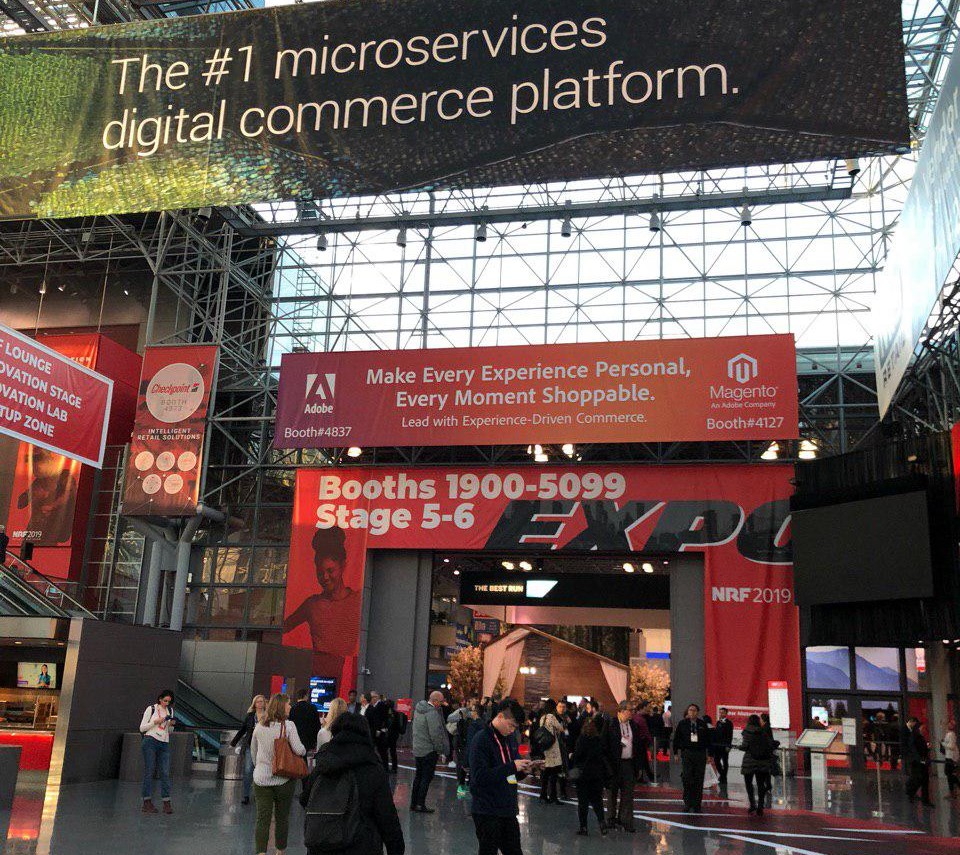The future of retail: the main digital trends based on NRF Retail's Big Show 2019

The world's largest retail conference and expo, NRF Retail's Big Show 2019, was held from January 13 to 15 in New York.
We visited the exhibition and tried to learn about all innovations in the field of retail and technologies to create the best customer experience.
What awaits retail in the future and what does artificial intelligence, computer vision and personalization have to do with this? We will try to summarize the results of the exhibition and tell you about the most important things we saw at NRF 2019.
“Digitalize or die!”
First of all - why did we go to the exhibition?
Mainly because we are interested in the achievements of advanced IT companies, as well as the successful experience of retailers who have introduced advanced technologies. But in addition, we wanted to catch the most recent and barely formed trends.
English-language media say that starting in 2012, general sentiment in retail was decadent and described the situation as “Apocalypse of retail”; by 2016, the situation went into the “Denial of retail” stage, but already in the next 2017, they began to talk about the beginning of “Revival retail ”.
Today they are announcing the beginning of a new phase - “The Time of Change”.
Over the past few years, a record number of retail stores have closed in the United States. This means only one thing: it is difficult to withstand price competition with online retailers. At the same time, online retailers continue to capture the niche of grocery retail, which was previously closed to them. By 2020, it is expected that 20% of all food products will be purchased online and delivered to your home.
We believe that this will change the industry beyond recognition. In order to stay afloat, retailers put all their efforts into transferring all the advantages of an online store offline. And investing in technology is something that really brings returns.
The main message of the event is that today's society is a world closely connected by technologies, and this must be considered. At the same time, key players have changed: those who accepted the new rules or create them themselves came to the place of self-confident giants like Macy's. They came to the exhibition to share experiences and teach others to change.
What technologies rule the ball in retail today?
We were at the exhibition last year and we can say that the rapid development of computer vision technology is striking. What has recently seemed impossible is now being applied everywhere: in security, in automating the work of cash registers, in equipping robots and shop windows, in checking price tags, etc.
Significantly advanced and accelerated analyst based on artificial intelligence. It is difficult to find a product at the exhibition that would not have been developed using AI: from trained chat bots to smart sensors at retail outlets, which with the help of ML tell you when to replenish stocks. In just half an hour, a retailer can understand what is on the shelf, for example, there is a shortage of goods, or who is standing in front of a shop window and what to offer it additionally. In other words, artificial intelligence technologies will allow retailers to collect, process and analyze a large amount of data that they have accumulated, but do not know how to use effectively.
Despite the fact that many see the use of augmented and virtual reality technology exclusively in the gaming or industrial sphere, this direction has all the chances to be used in retail. For example, show how your hair will look if you paint it in neon-pink, or how a new sofa will look in your living room.
Technology closer to you, you are closer to the buyer
Another noticeable trend is that technologies are becoming available, and this facilitates contact with the buyer. The exhibition included many projects using computer vision technologies, individual pricing systems, automation of routine actions of store employees, as well as mobile solutions designed to improve user experience. It seems that the idea of creating a positive consumer experience literally captured the industry.
In particular, for many years they have been talking about the omni-channel and mobility of user experience, although in fact, e-commerce and offline retail are still quite strongly separated. However, this year several companies proposed new ideas for creating an effective omnichannel strategy.
A big bet is made on the development of retail delivery: how to organize it, how to reduce costs and how to improve the quality of services. Organization of delivery from the store becomes a key moment in the formation of loyalty and further building long-term relationships with the buyer.
The idea of personification of the price offer is also connected with this. Just bring the smartphone with the included application to the shelf and see the price calculated for you. We spoke with a representative of a Swiss company that managed to increase customer retention rates by 25% after introducing individual pricing.
An important trend in IT remains the security of personal data. Privacy is beginning to be taken seriously, and there are many companies offering products and services in this direction.
Many startups in the field of automation of routine operations. If last year, customer-centricity was already spoken of as the main trend in retail, now automation of processes has been added to this as an effective way to increase profitability.
You can look at it another way: now the concept of customer-centricity is inseparable from technology. The consumer experience itself becomes different: the buyer comes to the store, where there is no line, and sometimes the service personnel, while the retailer already knows who came and what to offer.
It turns out that IT companies today need to think about the customer - an offline retailer, and to develop efficient, high-tech, yet affordable solutions today.
